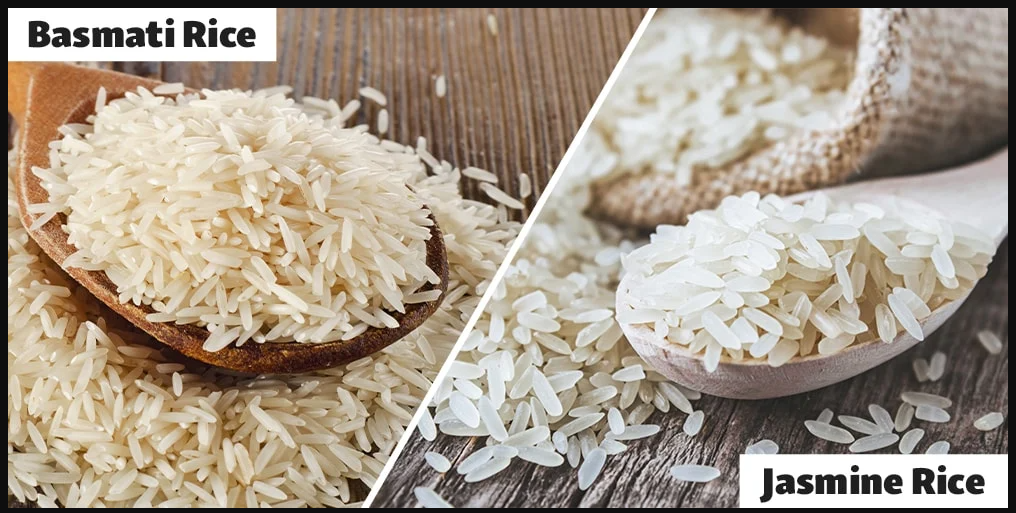Basmati Rice vs. Jasmine Rice: A Flavorful Face-Off

Rice is a staple in many cuisines around the world, and among the myriad varieties available, Basmati and Jasmine rice are two of the most popular. Both are aromatic and versatile, but they have distinct characteristics that make each one unique. In this blog, we’ll delve into the differences between Basmati and Jasmine rice, exploring their origins, flavors, textures, and best uses.
1. Origins and History
Basmati Rice: Basmati rice is native to the Indian subcontinent, particularly India. The name “Basmati” comes from the Sanskrit word “Vasmati,” which means “fragrant” or “pleasant-smelling.” This long-grain rice has been cultivated in the region for centuries, and it is often associated with traditional Indian and Pakistani cuisine.
Jasmine Rice: Jasmine rice, also known as Thai fragrant rice, originates from Thailand. Named after the jasmine flower for its floral aroma, this rice is a staple in Thai cooking. The variety is relatively new compared to Basmati, gaining popularity in the latter half of the 20th century as global interest in Thai cuisine grew.
2. Aroma and Flavor
Basmati Rice: Basmati rice is renowned for its distinct, nutty aroma and delicate, slightly spicy flavor. Its fragrance is often described as floral and is due to the presence of a compound called 2-acetyl-1-pyrroline. The flavor is subtle yet pronounced, making it a great complement to rich, spiced dishes.
Jasmine Rice: Jasmine rice has a sweet, floral aroma reminiscent of jasmine flowers, hence its name. The flavor is mildly nutty and buttery, with a slight hint of sweetness. This aromatic profile pairs well with the lighter, fresh flavors often found in Thai cuisine.
3. Texture and Appearance
Basmati Rice: Basmati rice grains are long, slender, and separate when cooked. They have a light, fluffy texture that makes them ideal for pilafs and biryanis where you want the grains to remain distinct. Basmati rice typically has a white or light brown color, depending on whether it is polished or whole grain.
Jasmine Rice: Jasmine rice grains are medium to long, with a slightly sticky texture when cooked. The grains have a tendency to clump together, making them suitable for dishes where the rice needs to hold together, such as stir-fries or as a base for curry. Jasmine rice is usually white but can also be found in a brown variety.
4. Cooking Methods
Basmati Rice: Basmati rice benefits from soaking before cooking, which helps elongate the grains and improve the texture. It is typically cooked with a 1:1.5 to 1:2 rice-to-water ratio, depending on the cooking method. Basmati rice is often prepared using the absorption method or a rice cooker.
Jasmine Rice: Jasmine rice generally requires a 1:1.25 to 1:1.5 rice-to-water ratio. It is cooked with minimal water, allowing the rice to remain slightly sticky. Jasmine rice can be cooked using a rice cooker, stovetop, or in a pot with a tight-fitting lid to keep the moisture in.
5. Best Uses
Basmati Rice:
- Indian Cuisine: Perfect for biryanis, pilafs, and as a side for curries.
- Middle Eastern Dishes: Great for kebabs, shawarma, and as a base for stews.
- Special Occasions: Often used in dishes for festive and celebratory meals due to its aromatic and flavorful profile.
Jasmine Rice:
- Thai Cuisine: Ideal for accompanying Thai curries, stir-fries, and grilled meats.
- Vietnamese Dishes: Complements dishes like pho and banh xeo.
- Everyday Meals: Its slightly sticky texture makes it versatile for various Asian-inspired dishes.
6. Nutritional Considerations
Basmati Rice: Basmati rice is available in both white and brown varieties. The brown version retains the bran and germ, offering more fiber and nutrients. White Basmati rice, while less nutritious, still provides essential carbohydrates.
Jasmine Rice: Jasmine rice is typically available as white rice, but brown Jasmine rice is also an option. Brown Jasmine rice offers more fiber and nutrients compared to its white counterpart. The white version is higher in carbohydrates but has a softer texture.
Conclusion
Both Basmati and Jasmine rice bring their own unique qualities to the table, making them valuable additions to any pantry. Basmati rice shines with its long, fluffy grains and aromatic, nutty flavor, while Jasmine rice offers a slightly sticky texture and sweet, floral aroma. Understanding the differences between these two varieties allows you to choose the best one for your culinary needs, ensuring that each dish is perfectly complemented by its accompanying rice.
Next time you’re deciding between Basmati and Jasmine rice, consider the dish you’re preparing and the flavor profile you want to achieve. Both types of rice have their own merits, and experimenting with each can add a delightful touch to your cooking.
- Industry
- Art
- Causes
- Crafts
- Dance
- Drinks
- Film
- Fitness
- Food
- Spellen
- Gardening
- Health
- Home
- Literature
- Music
- Networking
- Other
- Party
- Religion
- Shopping
- Sports
- Theater
- Wellness
- News


